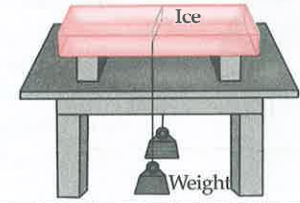Complete Solutions to EXERSICE of chapter HEAT of Class 10 book with complete answers and questions
| Class 10 | PHYSICS |
| Chapter | HEAT |
| CHETANA PUBLICATION | EXERSICE |
| Number Of Questions | 39 |
| Academic Year | 2023-24 |
The speciF1c heat capacity of ______is maximum.
02:13View SolutionIf temperature of water increases for `1^@C` to `3^@C` the density of water_____
02:28View SolutionAquatic plants and animals can survive in cold region because of _____ A. humidity B. dew point C. heat capacity D. anomalous behavior of water
03:19View SolutionWater is such a substance which ____at `O^@C` upto `4^@C`
02:02View SolutionIf temperature of water is lowered form `4^@C` to `3^@C` its volume_____
02:09View SolutionThe specific heat capacity is measured in C.G.S. system in_____.
01:57View SolutionAt dew point the relative humidity is __ A. 0.1 B. 1 C. 10 D. 100
02:33View SolutionIf the pressure is applied on ice, its melting point_____. A. decreases B. increases C. remains the same D. Fluctuates
02:31View SolutionThe specific heat capacity of water is ____kcal/kg °C
02:01View SolutionWhen water boils and is converted into steam,then_____
02:29View SolutionIn Hope's apparatus when the temperature of water drops from `4^@C` water____ A. remains still B. moves upwards C. moves downwards D. freezes solid
03:54View SolutionWhich of the following is a correct relation?
01:26View SolutionWhy do street ice cream vendors add salt their freezing mixture intermittently? A. to increase the melting point of the freezing mixture. B. to maintain the melting point of the freezing mixture as C. to reduce the melting point of the freezing mixture D. to reduce the weight of the freezing mixture
03:45View SolutionHeat needed to raise the temperatre of 1 kg of water from `14.5^@C` to `15.5^@C` is_____
01:55View SolutionHeat is absorbed when_____.
02:39View SolutionHeat absorbed when 1 g of ice melts at `0^@C` to form 1 g of water at the same temperature is ______cal
01:52View SolutionA sample of air containing certain amount of water vapour is saturated at a particular temperature. if the temperature of air sample is raised further, then____.
03:29View SolutionThe SI system,heat is measured in____- A. Calone B. kilocalone C. joules D. kelvin
01:26View SolutionComplete the analogy:
Boiling point of water: 100 °C :: Melting point of ice:____01:59View SolutionHow much heat is required to raise the temperature of 500 g of mercury from `20^@` to `100^@`C.(sp.heat capacity of Hg is 0.033 kcal/ `kg^@C`)
02:24View SolutionCalculate the heat absorbed if the initial temperature of 50g ice is `0^@C` to change into water of the same temperature (Latent heat of fusion of ice is `80 cal//g`)
01:49View SolutionCalculate the amount of heat absorbed by 100 g of ice to change into water of `30^@`C.(Latent heat of fusion of ice is `80 cal//g`)
03:38View SolutionCalculate the amount of heat absorbed by 500 g of ice to change into water of `20^@C`. (specific heat capacity of water is `1 cal//g^@C`)
03:32View SolutionA solid of mass 250 g at `90^@C` is dropped in a calorimeter containing 100 g of water at `15^@c`.The resulting temperature of mixture becomes `40^@C` The mass of calorimeter is 100 g and its specific heat capacity is 0.1 `cal//g^@C`. Find the specific heat capacity of the solid
07:20View SolutionA copper sphere of mass 500 g is heated `100^@C` and then introduced into copper calorimeter containing 100 g of water at `20^@C`. Find the maximum temperature of the mixture, if the mass of calorimeter is 100 g and specific heat capacity is 0.1 `cal//g^@C`
07:07View SolutionThe specific heat capacity of _____ is maximum
02:03View SolutionAquatic plants and animals can survive in cold region because of _____ A. humidity B. dew point C. heat capacity D. anomalous behavior of water
03:19View SolutionComplete the analogy:
Dry air: less than 60% relative humidity ::Humid air ________01:38View Solutiontrue or false:
At `4^@C` the volume of water is maximum02:11View SolutionComplete the analogy:
CGS unit of heat: calorie:: CGS unit of heat capacity:____01:54View SolutionGive scientific reasons:
In cold regions in winter the Pipes for water supply break and even rocks crack.03:24View SolutionDistinguish between:
What is the difference between heat and temperature?04:29View SolutionEqual heat is given to two objects A and B of mass 1 g. temperature of A increases by `3^@C` and B by `5^@C` which object has more specific heat ? And by what factor?
02:47View SolutionAnswer the following based on the diagram given below. Above experiment is meant to understand which phenomenon of heat?
 06:28View Solution
06:28View SolutionAnswer the following based on the diagram given below What is the effect of the increase in pressure on the melting point of ice?
 03:58View Solution
03:58View SolutionA calorimeter has mass 100 g and specific heat 0.1 `kcal//kg^@C`.It contains 250 gm of liquid at `30^@C` having specific heat of 0.4 `kcal//kg^@C`. If we drop a Piece of ice mass 10 g at `0^@C`, what will be the temperature of the mixture?
08:34View SolutionIf 80 g steam of temperature `97^@C` is released on an ice slab of temperature `0^@C` ,how much ice will melt?How much energy will be transferred to water? Given : specific heat capacity of water, c = 1 cal/g °C Latent heat of melting of ice = 80 cal/g Latent heat of vaporization of water = 540 cal/g
05:32View SolutionIn Hope's apparatus when the temperature of water drops from `4^@C` water____ A. remains still B. moves upwards C. moves downwards D. freezes solid
03:54View SolutionAnswer in one sentence:
Where does the latent heat go during these transformation ?01:34View Solution
EXERSICE questions and complete solutions for chapter HEAT of CHETANA PHYSICS (MARATHI ENGLISH) of Class 10
